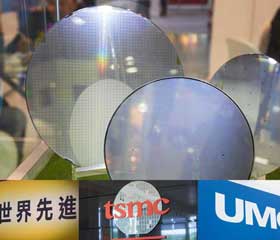
Digitimes Research's Special Report on Taiwan's semiconductor foundry sector studies the three major Taiwanese foundry houses: Taiwan Semiconductor Manufacturing Company (TSMC), United Microelectronics Corporation (UMC) and Vanguard International Semiconductor (VIS). The report provides an analysis of the foundry houses' results and the overall market conditions in first-half 2019, and looks at their prospect in the second half of the year.
With global market demand on a moderate increase in second-quarter 2019, Taiwan-based semiconductor foundries showed recovery. Taiwan Semiconductor Manufacturing Company (TSMC), United Microelectronics Corporation (UMC) and Vanguard International Semiconductor (VIS) together generated total revenues of US$9.13 billion in the second quarter, up 8.9% on quarter but down 2.5% on year.
During the second quarter, unfavorable circumstances including weakening global economy, foundry customers waiting to deplete inventory and the smartphone market reaching saturation were exerting pressure on Taiwan-based semiconductor foundries. But Taiwan-based semiconductor foundries were able to deliver sequential revenue growth, thanks to some downstream clients starting early inventory preparations, some others enjoying growing market shares, and TSMC shaking off the impact from the photoresist incident that had hit its production earlier.
In terms of manufacturing nodes, as a result of TSMC delaying shipments for some orders until second-quarter 2019 due to the production incident, 20/16/14/12nm process technologies rose to become the main revenue generator for Taiwan-based foundries in second-quarter 2019. The share of revenues contributed by advanced process nodes (28nm and beyond) increased sequentially but it did not return to the level seen in fourth-quarter 2018. Their average selling price (ASP) was also buoyed by the sequential increase in the share of revenues contributed by advanced process nodes.
Looking into second-half 2019, moderate increase in end market demand will drive capacity utilization, hoisting Taiwan-based foundries' revenues back above the US$10 billion mark in third-quarter 2019 with further growth in fourth-quarter 2019. Revenues from 7nm and more advanced nodes are expected to be strong, as demand from 5G and AI sectors picks up. Revenues generated by 7nm and more advanced nodes will show increases, pushing Taiwan-based semiconductor foundries' ASP higher.
Taiwan-based semiconductor foundries can expect growth momentum because of a number of reasons: Apple's new iPhones are entering the market; Huawei's supply chain is seeing orders return; the traditional high season for the electronics industry is coming; and demand for 5G applications is emerging. But the growth momentum may be limited with the smartphone market saturating and consumers putting off phone upgrades pending full 5G commercialization, on top of uncertainties over the US-China trade tensions. Accordingly, Digitimes Research estimates Taiwan-based semiconductor foundries' whole-year 2019 revenues will see a mild decline on year.
Table: Key factors affecting Taiwan foundry industry in 2Q19 and 3Q19
Chart 3: Taiwan foundry revenues by player, 2Q18-4Q19 (US$m)
Chart 5: Taiwan foundry revenues by manufacturing process, 1Q18-2Q19 (US$m)
Chart 6: Taiwan foundry revenue share by manufacturing process, 1Q18-2Q19
Chart 7: TSMC revenues by manufacturing process, 1Q18-2Q19 (US$m)
Chart 8: TSMC revenue share by manufacturing process, 1Q18-2Q19
Chart 10: UMC revenues by manufacturing process, 1Q18-2Q19 (US$m)
Chart 11: UMC revenue share by manufacturing process, 1Q18-2Q19
Chart 12: VIS revenues by manufacturing process, 1Q18-2Q19 (US$m)
Chart 13: VIS revenue share by manufacturing process, 1Q18-2Q19
Chart 14: Taiwan foundry wafer ASP, 1Q18-2Q19 (US$/8-inch wafer equivalent)

